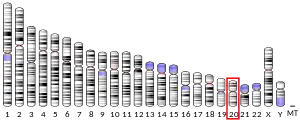| PIGU | |||||||||||||||||||||||||||||||||||||||||||||||||||
|---|---|---|---|---|---|---|---|---|---|---|---|---|---|---|---|---|---|---|---|---|---|---|---|---|---|---|---|---|---|---|---|---|---|---|---|---|---|---|---|---|---|---|---|---|---|---|---|---|---|---|---|
| Identifiers | |||||||||||||||||||||||||||||||||||||||||||||||||||
| Aliases | PIGU, CDC91L1, GAB1, phosphatidylinositol glycan anchor biosynthesis class U, GPIBD21, NEDBSS | ||||||||||||||||||||||||||||||||||||||||||||||||||
| External IDs | OMIM: 608528 MGI: 3039607 HomoloGene: 6553 GeneCards: PIGU | ||||||||||||||||||||||||||||||||||||||||||||||||||
| |||||||||||||||||||||||||||||||||||||||||||||||||||
| |||||||||||||||||||||||||||||||||||||||||||||||||||
| |||||||||||||||||||||||||||||||||||||||||||||||||||
| |||||||||||||||||||||||||||||||||||||||||||||||||||
| |||||||||||||||||||||||||||||||||||||||||||||||||||
| Wikidata | |||||||||||||||||||||||||||||||||||||||||||||||||||
| |||||||||||||||||||||||||||||||||||||||||||||||||||
Phosphatidylinositol glycan anchor biosynthesis class U protein is a protein that in humans is encoded by the PIGU gene.[5][6][7]
The protein encoded by this gene shares similarity with Saccharomyces cerevisiae Cdc91, a predicted integral membrane protein that may function in cell division control. The protein encoded by this gene is the fifth subunit of GPI transamidase that attaches GPI-anchors to proteins.[7]
References
- 1 2 3 GRCh38: Ensembl release 89: ENSG00000101464 - Ensembl, May 2017
- 1 2 3 GRCm38: Ensembl release 89: ENSMUSG00000038383 - Ensembl, May 2017
- ↑ "Human PubMed Reference:". National Center for Biotechnology Information, U.S. National Library of Medicine.
- ↑ "Mouse PubMed Reference:". National Center for Biotechnology Information, U.S. National Library of Medicine.
- ↑ Hong Y, Ohishi K, Kang JY, Tanaka S, Inoue N, Nishimura J, Maeda Y, Kinoshita T (Jun 2003). "Human PIG-U and yeast Cdc91p are the fifth subunit of GPI transamidase that attaches GPI-anchors to proteins". Mol Biol Cell. 14 (5): 1780–9. doi:10.1091/mbc.E02-12-0794. PMC 165076. PMID 12802054.
- ↑ Guo Z, Linn JF, Wu G, Anzick SL, Eisenberger CF, Halachmi S, Cohen Y, Fomenkov A, Hoque MO, Okami K, Steiner G, Engles JM, Osada M, Moon C, Ratovitski E, Trent JM, Meltzer PS, Westra WH, Kiemeney LA, Schoenberg MP, Sidransky D, Trink B (Apr 2004). "CDC91L1 (PIG-U) is a newly discovered oncogene in human bladder cancer". Nat Med. 10 (4): 374–81. doi:10.1038/nm1010. PMID 15034568. S2CID 900186.
- 1 2 "Entrez Gene: PIGU phosphatidylinositol glycan anchor biosynthesis, class U".
Further reading
- Ohishi K, Inoue N, Kinoshita T (2001). "PIG-S and PIG-T, essential for GPI anchor attachment to proteins, form a complex with GAA1 and GPI8". EMBO J. 20 (15): 4088–98. doi:10.1093/emboj/20.15.4088. PMC 149153. PMID 11483512.
- Deloukas P, Matthews LH, Ashurst J, et al. (2002). "The DNA sequence and comparative analysis of human chromosome 20". Nature. 414 (6866): 865–71. Bibcode:2001Natur.414..865D. doi:10.1038/414865a. PMID 11780052.
- Strausberg RL, Feingold EA, Grouse LH, et al. (2003). "Generation and initial analysis of more than 15,000 full-length human and mouse cDNA sequences". Proc. Natl. Acad. Sci. U.S.A. 99 (26): 16899–903. Bibcode:2002PNAS...9916899M. doi:10.1073/pnas.242603899. PMC 139241. PMID 12477932.
- Clark HF, Gurney AL, Abaya E, et al. (2003). "The secreted protein discovery initiative (SPDI), a large-scale effort to identify novel human secreted and transmembrane proteins: a bioinformatics assessment". Genome Res. 13 (10): 2265–70. doi:10.1101/gr.1293003. PMC 403697. PMID 12975309.
- Vainauskas S, Menon AK (2004). "A conserved proline in the last transmembrane segment of Gaa1 is required for glycosylphosphatidylinositol (GPI) recognition by GPI transamidase". J. Biol. Chem. 279 (8): 6540–5. doi:10.1074/jbc.M312191200. PMID 14660601.
- Gerhard DS, Wagner L, Feingold EA, et al. (2004). "The status, quality, and expansion of the NIH full-length cDNA project: the Mammalian Gene Collection (MGC)". Genome Res. 14 (10B): 2121–7. doi:10.1101/gr.2596504. PMC 528928. PMID 15489334.
- Otsuki T, Ota T, Nishikawa T, et al. (2007). "Signal sequence and keyword trap in silico for selection of full-length human cDNAs encoding secretion or membrane proteins from oligo-capped cDNA libraries". DNA Res. 12 (2): 117–26. doi:10.1093/dnares/12.2.117. PMID 16303743.
This article is issued from Wikipedia. The text is licensed under Creative Commons - Attribution - Sharealike. Additional terms may apply for the media files.



